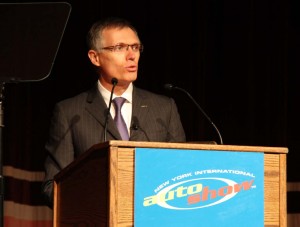
Nissan will sharply increase the use of locally-produced parts, reducing its reliance on Japanese suppliers.
Nissan will sharply expand the use of locally-produced parts at its North American assembly plants, said Carlos Tavares, president of Nissan Americas.
That move will come at the same time the second-largest Japanese maker shifts production of more of its vehicles, including the Rogue crossover from Japan to factories in the U.S., Canada and Mexico.
“We will significantly reduce the number of parts coming from Japan,” said Tavares, keynote speaker at the 2011 New York Auto Show. The goal is to jump from the current level of 69% locally-sourced components to 85%, he added.
Like rivals Honda and Toyota, Nissan was hard hit by the series of disasters that struck Japan on March 11, losing the better part of a month of production in the home market alone. But Tavares said all of Nissan’s plants are now in operation, the maker having found ways to “bypass parts shortages” caused by the crisis.
In his speech and a subsequent question-and-answer session, the Portugese-born Tavares stressed that there were other reasons to source locally besides the parts shortages – and the possibility of future earthquakes and tsunamis. The strong yen, for one thing, since that forces up the price of Japanese-made goods.
In a separate announcement, Tavares reported that Nissan has so far sold over 500 Leaf battery cars in the U.S., and has been struggling to meet demand, some customers waiting three or four months to take delivery.
The situation was complicated by the Japanese natural disaster, but a boatload of 127 battery cars left from a Japanese port on April 5 and will reach Los Angeles next week.
Going forward, the CEO said, “U.S. deliveries are about to go from the 100s to the many 1000s,” allowing Nissan to re-open its pre-order program.
The maker had been hoping to sell 20,000 Leafs in the U.S. this year, though it remains to be seen if the shortages will lead it to miss that target.
